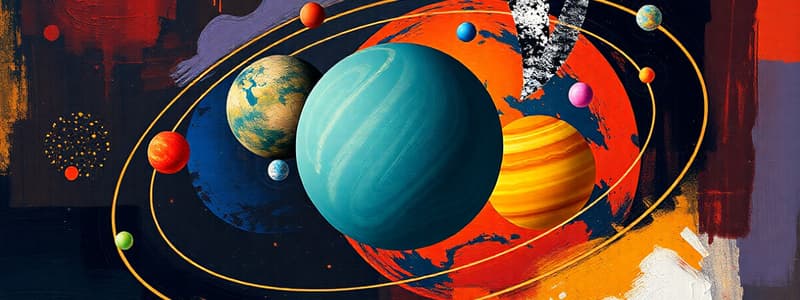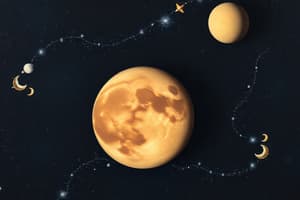Podcast
Questions and Answers
According to the International Astronomical Union, what is a key criterion for a celestial body to be classified as a planet?
According to the International Astronomical Union, what is a key criterion for a celestial body to be classified as a planet?
- It must have a complex atmospheric composition.
- It must have cleared the area of its orbit of smaller objects. (correct)
- It must be composed primarily of rock and metal.
- It must be located within the asteroid belt.
What distinguishes a dwarf planet from a planet, according to the International Astronomical Union?
What distinguishes a dwarf planet from a planet, according to the International Astronomical Union?
- Dwarf planets have not cleared the area around their orbit of smaller objects. (correct)
- Dwarf planets do not orbit a star.
- Dwarf planets are not massive enough to be nearly spherical.
- Dwarf planets have cleared the area around their orbit of smaller objects.
What is the significance of an astronomical unit (AU) in the context of our solar system?
What is the significance of an astronomical unit (AU) in the context of our solar system?
- It is used to measure the mass of celestial objects.
- It standardizes measurements to the distance between Earth and the Sun. (correct)
- It defines the boundary of the solar system.
- It represents the distance light travels in one year.
How does the distance of a planet from the Sun generally affect its orbital period?
How does the distance of a planet from the Sun generally affect its orbital period?
Approximately how much more massive is the Sun compared to the combined mass of all other objects in the solar system?
Approximately how much more massive is the Sun compared to the combined mass of all other objects in the solar system?
Which of the following sequences correctly lists the planets and Ceres in order of increasing distance from the Sun?
Which of the following sequences correctly lists the planets and Ceres in order of increasing distance from the Sun?
What are the two primary regions that broadly categorize the layout of our solar system?
What are the two primary regions that broadly categorize the layout of our solar system?
Which of these correctly lists all the inner planets of our solar system?
Which of these correctly lists all the inner planets of our solar system?
Which of the following planets are classified as outer planets?
Which of the following planets are classified as outer planets?
How does Pluto's orbit differ from the orbits of the eight recognized planets in our solar system?
How does Pluto's orbit differ from the orbits of the eight recognized planets in our solar system?
What is the Kuiper Belt primarily known for?
What is the Kuiper Belt primarily known for?
What is characteristic of the objects residing in the scattered disk region of the solar system?
What is characteristic of the objects residing in the scattered disk region of the solar system?
What is the primary function of the heliosphere?
What is the primary function of the heliosphere?
What did the ancient astronomers originally mean when they used the term 'planet'?
What did the ancient astronomers originally mean when they used the term 'planet'?
Which technology was first employed to observe the moons of Jupiter, and who was the scientist who made these observations?
Which technology was first employed to observe the moons of Jupiter, and who was the scientist who made these observations?
Approximately when did our solar system form?
Approximately when did our solar system form?
What was the primary composition of the nebula that eventually formed our solar system?
What was the primary composition of the nebula that eventually formed our solar system?
What fundamental process defines our Sun as a star?
What fundamental process defines our Sun as a star?
What is the key difference between a planet and a moon?
What is the key difference between a planet and a moon?
What is the fundamental force that causes planets to orbit stars?
What is the fundamental force that causes planets to orbit stars?
Flashcards
Requirements to be a planet?
Requirements to be a planet?
To be a planet, it must orbit a star, be big enough to be a sphere due to its own gravity, be small enough that it isn't a star, and have cleared its orbit of smaller objects.
Requirements to be a dwarf planet?
Requirements to be a dwarf planet?
To be a dwarf planet, it must orbit a star, have enough mass to be nearly spherical, not have cleared the area around its orbit, and not be a moon.
What is an astronomical unit?
What is an astronomical unit?
It is the average distance from the Earth to the Sun ( 150 MKm)
Distance vs. Orbital Periods?
Distance vs. Orbital Periods?
Signup and view all the flashcards
Mass of our sun compared to the solar system?
Mass of our sun compared to the solar system?
Signup and view all the flashcards
Order of planets and dwarf planets?
Order of planets and dwarf planets?
Signup and view all the flashcards
Two main regions of the solar system?
Two main regions of the solar system?
Signup and view all the flashcards
List the inner planets.
List the inner planets.
Signup and view all the flashcards
List the outer planets
List the outer planets
Signup and view all the flashcards
Pluto's orbital plane different?
Pluto's orbital plane different?
Signup and view all the flashcards
What is the Kuiper Belt?
What is the Kuiper Belt?
Signup and view all the flashcards
What is happening in the scattered disk?
What is happening in the scattered disk?
Signup and view all the flashcards
What is the heliosphere?
What is the heliosphere?
Signup and view all the flashcards
What did "planet" mean to ancient astronomers?
What did "planet" mean to ancient astronomers?
Signup and view all the flashcards
Technology to observe Jupiter's moons?
Technology to observe Jupiter's moons?
Signup and view all the flashcards
When did our Solar system form?
When did our Solar system form?
Signup and view all the flashcards
Main composition of solar nebula?
Main composition of solar nebula?
Signup and view all the flashcards
Why is our sun a star?
Why is our sun a star?
Signup and view all the flashcards
Difference between a planet and a moon?
Difference between a planet and a moon?
Signup and view all the flashcards
Why do planets orbit stars?
Why do planets orbit stars?
Signup and view all the flashcards
Study Notes
- Requires a link to external reference material
Requirements to be a planet, according to the International Astronomical Union (IAU):
- Orbit a star
- Possess enough gravity to be shaped as a sphere
- Not be a star itself
- Have cleared its orbital area of smaller objects
Requirements to be a dwarf planet, according to the IAU:
- Orbit a star
- Have enough mass to be nearly spherical
- Not have cleared the area around its orbit of smaller objects
- Not be a moon
Astronomical Unit
- Average distance from Earth to the Sun: 150 MKm
Distance of Planets from the Sun and Orbital Periods
- The closer to the sun, the shorter the orbital period
Mass of the Sun Compared to the Solar System
- The sun's mass is 500 times more massive than the combined mass of everything else in the solar system
Order of the Planets and Dwarf Planets by Distance from the Sun:
- Mercury, Venus, Earth, Mars, Ceres (in the asteroid belt), Jupiter, Saturn, Uranus, Neptune, Pluto, Haumea, Makemake, Eris
Two Main Regions of the Solar System:
- inner planets
- outer planets
Inner Planets
- Mercury
- Venus
- Earth
- Mars
Outer Planets
- Jupiter
- Saturn
- Uranus
- Neptune
Pluto's Orbit
- Tilted in relation to the other planets
- Shaped like a long, narrow ellipse
- It sometimes passes inside Neptune’s orbit
Kuiper Belt
- Region beyond Neptune where Pluto and many other asteroid-like objects revolve around the Sun
- Most of solar systems comets are in the Kuiper Belt
Scattered Disk
- Region filled with strangely orbiting objects and minor planets
Heliosphere
- Magnetic bubble forming the outer edge of the solar system
- Boundary between the solar and interstellar winds
Ancient Astronomers Definition of a Planet
- Wandering stars
First Technology Used to Observe Jupiter's Moons
- Telescope, by Galileo.
Solar System Formation
- 4.6 B.Y.A
Main Composition of Nebula Forming the Solar System
- H and He
Why Our Sun Is A Star
- It emits more energy than it absorbs
Difference Between Planets and Moons
- A planet revolves around a star
- A moon revolves around a planet
Why Planets Orbit Stars
- Gravity
Possible Existence of a Ninth Planet
- Explained by distant dwarf planets beyond Pluto moving on large elliptical orbits
- Its orbits are caused by a gravitational pull of an object large enough to distort the orbit
Studying That Suits You
Use AI to generate personalized quizzes and flashcards to suit your learning preferences.




